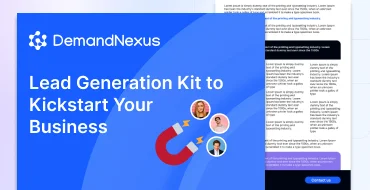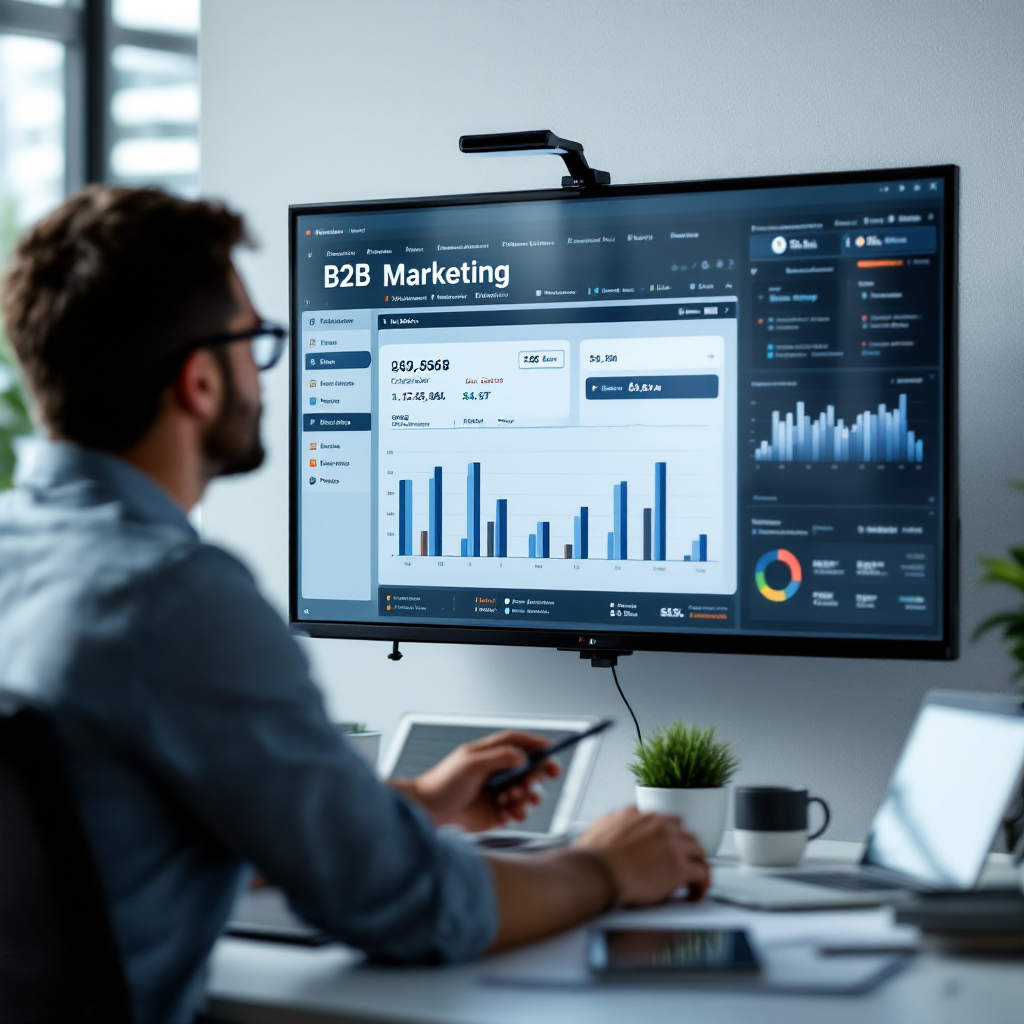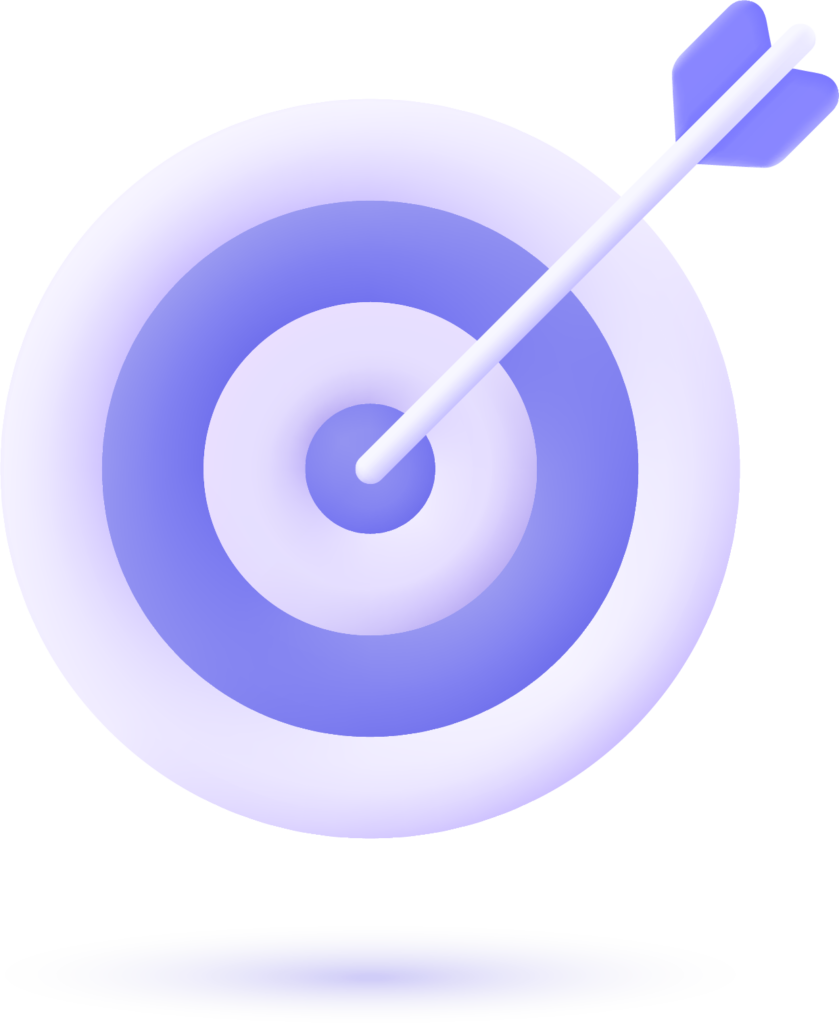Modern B2B buyers complete 77% of their research independently before engaging with sales teams, making your marketing funnel the primary vehicle for educating, nurturing, and converting prospects. Unlike B2C funnels that focus on quick emotional decisions, B2B marketing funnels address complex organizational buying processes involving multiple stakeholders and extended decision cycles.
Understanding B2B Marketing Funnels
A B2B marketing funnel represents a strategic framework that maps the customer journey from initial problem recognition to final purchase decision. This systematic approach segments prospects based on their stage in the buying process, enabling you to deliver relevant content and messaging that moves them closer to conversion.
The fundamental difference between B2B and B2C funnels lies in complexity and duration. B2B purchasing decisions typically involve multiple decision-makers, require substantial financial investments, and span several months. Research shows that 74.6% of B2B sales take at least four months to close, with nearly half requiring seven months or more.
B2B marketing funnels create sustainable competitive advantages by:
- Mapping customer behavior patterns to understand how prospects interact with your brand
- Personalizing messaging based on specific buyer journey stages
- Optimizing resource allocation by focusing efforts on high-intent prospects
- Measuring performance through clear metrics at each funnel stage
- Aligning sales and marketing teams around common revenue goals
The Three Core Stages of B2B Marketing Funnels
Top of Funnel (TOFU): Building Awareness
The awareness stage captures prospects who recognize business problems but haven’t identified specific solutions. Your primary objective centers on educating potential customers while establishing thought leadership and brand credibility.
Key Strategies for TOFU:
- Content Marketing: Publish comprehensive blog posts, whitepapers, and research reports that address industry challenges
- Search Engine Optimization: Target informational keywords that prospects use during problem identification
- Social Media Engagement: Share valuable insights across LinkedIn and industry-specific platforms
- Paid Advertising: Run awareness campaigns targeting broad industry demographics
- Webinars and Events: Host educational sessions that demonstrate expertise without selling
Content at this stage should focus on problem identification and education rather than product promotion. For example, instead of highlighting your CRM features, create content about common sales productivity challenges and industry best practices.
Middle of Funnel (MOFU): Driving Consideration
The consideration stage engages prospects who understand their problems and actively research solutions. Your content strategy shifts toward demonstrating how your solutions address specific pain points while differentiating from competitors.
Effective MOFU Tactics:
- Case Studies: Showcase how similar companies solved comparable challenges
- Product Demonstrations: Offer interactive demos that highlight key capabilities
- Comparison Guides: Create objective evaluations between different solution approaches
- Email Nurture Campaigns: Deliver targeted content series based on prospect behavior
- Retargeting Campaigns: Re-engage website visitors with relevant solution-focused content
Lead scoring becomes critical during this stage to identify prospects showing purchase intent. Track engagement metrics like email opens, content downloads, and demo requests to prioritize follow-up activities.
Bottom of Funnel (BOFU): Converting Decisions
The decision stage targets prospects ready to evaluate specific vendors and make purchasing decisions. Your marketing efforts focus on removing final objections and facilitating the sales handoff process.
BOFU Conversion Strategies:
- Free Trials: Allow prospects to experience your solution firsthand
- Consultations: Offer personalized assessments of their specific requirements
- Testimonials: Share success stories from recognizable industry peers
- Pricing Information: Provide transparent cost structures and ROI calculations
- Implementation Support: Address concerns about onboarding and change management
Sales and marketing alignment becomes crucial at this stage to ensure smooth prospect transitions and consistent messaging throughout the closing process.
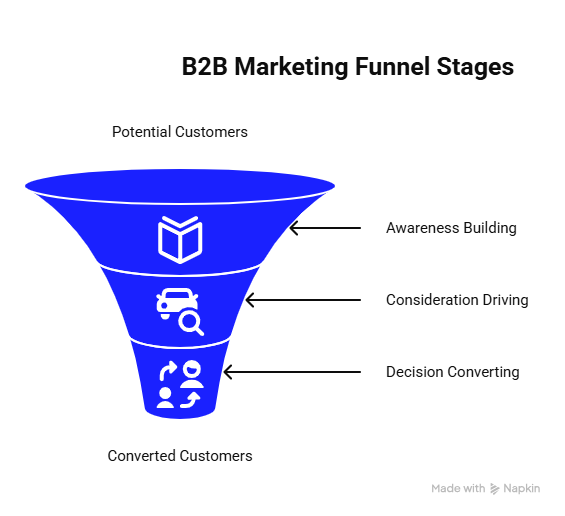
Implementation Framework for B2B Marketing Funnels
Step 1: Define Target Audience and Buyer Personas
Start by conducting comprehensive research to understand your ideal customer profile. Gather data through surveys, interviews, and analytics to identify:
- Job responsibilities and decision-making authority
- Pain points and business challenges
- Goals and success metrics
- Preferred communication channels
- Content consumption patterns
Create detailed buyer personas for each stakeholder type involved in purchasing decisions. Technical evaluators require different content than financial decision-makers or end users.
Step 2: Map Customer Journey Touchpoints
Identify every interaction point between your prospects and your brand. Document:
- Discovery channels where prospects first encounter your company
- Content preferences at each funnel stage
- Decision criteria that influence purchasing choices
- Communication timing that aligns with buying cycles
- Handoff processes between marketing and sales teams
This mapping exercise reveals gaps in your current funnel and opportunities for optimization.
Step 3: Develop Stage-Specific Content Strategies
Create content calendars that align with each funnel stage. Your content mix should include:
TOFU Content Examples:
- Industry trend reports
- Problem identification guides
- Educational blog posts
- Thought leadership articles
- Podcast appearances
MOFU Content Examples:
- Solution comparison matrices
- ROI calculators
- Vendor evaluation checklists
- Implementation timelines
- Feature demonstrations
BOFU Content Examples:
- Customer success stories
- Implementation case studies
- Pricing and packaging guides
- Security and compliance documentation
- Onboarding resources
Step 4: Implement Marketing Automation
Deploy CRM and marketing automation platforms to manage prospect progression through your funnel. Key automation capabilities include:
- Lead scoring based on behavioral and demographic data
- Email sequences triggered by specific actions
- Content personalization based on funnel stage
- Sales alerts when prospects show buying intent
- Performance tracking across all touchpoints
Tools like HubSpot, Marketo, or Pardot provide comprehensive funnel management capabilities for B2B organizations.
Step 5: Establish Measurement and Optimization Processes
Track key performance indicators (KPIs) at each funnel stage to identify improvement opportunities:
| Funnel Stage | Key Metrics | Benchmark Goals |
|---|---|---|
| TOFU | Website traffic, content downloads, email signups | 2-5% conversion to MOFU |
| MOFU | Email engagement, demo requests, content consumption | 10-15% conversion to BOFU |
| BOFU | Trial signups, proposal requests, sales meetings | 20-30% conversion to customers |
Regular funnel analysis helps identify bottlenecks where prospects drop off and optimization opportunities that improve conversion rates.
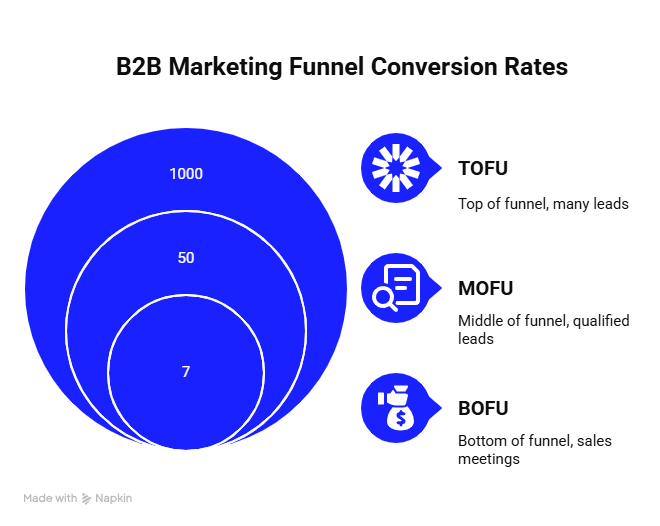
Advanced B2B Marketing Funnel Strategies
Email Marketing Optimization
Email marketing remains one of the most effective B2B marketing channels, with 59% of marketers citing it as their top revenue-generating funnel. Develop segmented email campaigns that deliver value at each funnel stage:
- Welcome series for new subscribers entering your funnel
- Educational sequences that build expertise and trust
- Product-focused campaigns for consideration-stage prospects
- Trial and demo invitations for decision-ready leads
Personalization significantly improves email performance. Use dynamic content based on industry, company size, or specific pain points to increase engagement rates.
Content Marketing Excellence
Content marketing drives 93% of B2B buying processes that start with online research. Create comprehensive content hubs that address every aspect of your prospects’ decision journey:
- Blog posts targeting long-tail keywords related to business problems
- Whitepapers that demonstrate deep industry expertise
- Video content explaining complex concepts or showcasing solutions
- Interactive tools like ROI calculators or assessment quizzes
Gate premium content behind lead capture forms to build your prospect database while providing immediate value.
Social Selling and LinkedIn Strategy
B2B decision-makers increasingly rely on social media for vendor research and peer recommendations. Develop social selling strategies that:
- Share valuable content that addresses industry challenges
- Engage with prospects through thoughtful comments and discussions
- Build relationships with key industry influencers
- Demonstrate expertise through consistent thought leadership
LinkedIn remains the primary B2B social platform, with 94% of B2B marketers using it for content distribution.
Account-Based Marketing Integration
For enterprise prospects, integrate account-based marketing approaches that personalize entire funnel experiences for high-value accounts. This strategy aligns sales and marketing efforts around specific target companies rather than individual leads.
Case Study: DemandNexus Transforms B2B Lead Generation
Challenge:
A growing SaaS company struggled with low-quality leads and poor conversion rates despite significant marketing investment. Their existing funnel generated high traffic volumes but failed to produce qualified prospects for their sales team.
Solution:
DemandNexus implemented a comprehensive funnel optimization strategy focusing on:
- Buyer persona refinement through extensive customer research
- Content strategy overhaul creating stage-specific educational resources
- Lead scoring implementation to prioritize high-intent prospects
- Sales and marketing alignment through shared metrics and processes
- Marketing automation deployment for consistent nurturing campaigns
Results:
Within six months, the client achieved:
- 300% increase in marketing qualified leads
- 45% improvement in lead-to-opportunity conversion rates
- 60% reduction in customer acquisition costs
- 2x growth in monthly recurring revenue
The transformation demonstrates how strategic funnel optimization creates measurable business impact when properly implemented and executed.
Measuring B2B Marketing Funnel Performance
Effective measurement requires tracking both leading and lagging indicators across your entire funnel. Key metrics include:
Lead Generation Metrics
- Traffic sources and their quality scores
- Conversion rates from visitor to lead
- Cost per lead across different channels
- Lead velocity through funnel stages
Engagement Metrics
- Email open and click rates by campaign type
- Content consumption patterns and preferences
- Website behavior including time on page and bounce rates
- Social media engagement and share rates
Conversion Metrics
- Marketing qualified lead (MQL) rates from total leads
- Sales qualified lead (SQL) conversion from MQLs
- Opportunity creation rates from SQLs
- Win rates and average deal sizes
Revenue Attribution
- Pipeline contribution from marketing activities
- Customer acquisition cost by channel and campaign
- Customer lifetime value from different lead sources
- Revenue per lead across funnel stages
Use these metrics to identify optimization opportunities and allocate resources toward highest-performing activities.
Common B2B Marketing Funnel Mistakes to Avoid
Focusing Only on Top-of-Funnel Volume
Many organizations obsess over lead quantity rather than quality, creating funnels that generate high volumes of unqualified prospects. This approach overwhelms sales teams and inflates customer acquisition costs. Focus on attracting prospects who match your ideal customer profile rather than maximizing raw lead numbers.
Neglecting Middle-of-Funnel Nurturing
The consideration stage requires substantial nurturing to move prospects toward purchase decisions. Organizations that skip this crucial phase often see high drop-off rates and lengthy sales cycles. Invest in comprehensive nurturing campaigns that educate prospects and build trust over time.
Poor Sales and Marketing Alignment
Disconnected sales and marketing teams create friction in prospect handoffs and inconsistent messaging. Establish clear lead qualification criteria, shared metrics, and regular communication processes to ensure seamless funnel progression.
Insufficient Content for Each Stage
Generic content that doesn’t address specific funnel stages fails to move prospects forward effectively. Create detailed content maps that align with each stage of your buyer journey and address specific questions or concerns.
Lack of Regular Optimization
Static funnels quickly become outdated as market conditions and buyer behaviors evolve. Implement regular testing and optimization processes to continuously improve performance and adapt to changing requirements.
Future Trends in B2B Marketing Funnels
Artificial Intelligence and Automation
AI-powered tools increasingly automate lead scoring, content personalization, and prospect nurturing. These technologies enable more sophisticated segmentation and real-time optimization based on individual prospect behaviors.
Video Content Integration
Video content becomes essential across all funnel stages, from educational webinars at the top to personalized demos at the bottom. Interactive video experiences provide more engaging ways to educate and convert prospects.
Intent Data Utilization
Third-party intent data helps identify prospects actively researching solutions before they enter your funnel. This intelligence enables proactive outreach and more targeted content delivery based on demonstrated interest signals.
Mobile Optimization
B2B buyers increasingly research solutions on mobile devices, requiring mobile-optimized funnel experiences. Responsive design and mobile-specific content formats become critical for funnel effectiveness.
Optimizing Your B2B Marketing Funnel with DemandNexus
Creating high-performing B2B marketing funnels requires expertise in strategy development, content creation, and performance optimization. DemandNexus specializes in building and managing comprehensive B2B sales funnels that generate qualified prospects and accelerate revenue growth.
Our team works with organizations across industries to implement proven funnel strategies including sales prospecting techniques, lead qualification processes, and demand generation campaigns that deliver measurable results. Through data-driven approaches and continuous optimization, we help businesses shorten sales cycles while improving conversion rates across all funnel stages.
Whether you need support with SaaS marketing funnels, prospecting tools implementation, or comprehensive sales enablement strategies, our proven methodologies transform marketing investments into predictable revenue engines.
Conclusion
B2B marketing funnels provide structured frameworks for converting prospects into customers through systematic nurturing and engagement strategies. Success requires understanding your target audience, creating stage-specific content, implementing proper measurement systems, and continuously optimizing based on performance data.
Organizations that invest in comprehensive funnel strategies see significant improvements in lead quality, conversion rates, and revenue growth. The key lies in taking a strategic approach that aligns marketing activities with buyer journey stages while maintaining focus on providing value throughout the process.
Start by auditing your current funnel performance, identifying gaps in your prospect journey, and developing targeted strategies for each stage. With proper implementation and ongoing optimization, your B2B marketing funnel becomes a powerful engine for sustainable business growth and competitive advantage in your market.
